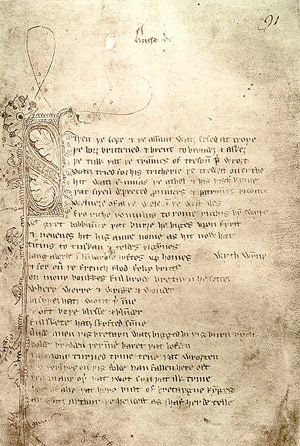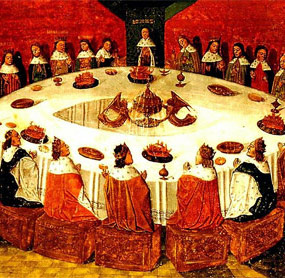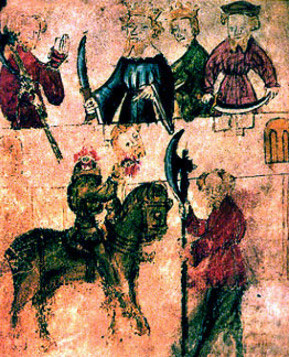Sir Gawain and the Green Knight:
BASIC FACTS:

Title: Sir Gawain and the Green Knight.
Author: Anonymous / The Pearl Poet.
Date of composition: Written in the late fourteenth century.
Date of publication: Unknown.
Setting(s): Camelot on New Year’s Day.
Language/dialect: Written in the dialect of Cheshire, a county in the Northwest Midlands of England on the border with Wales.
Genre: Middle English alliterative romance.
Type of narrator: Omniscient narrator.
Plot summary: The story begins in Camelot on New Year’s Day, as King Arthur’s court is celebrating Christmas. Suddenly, a gigantic green figure enters the hall riding a horse (The Green Knight). The knight proposes a game which consists of striking him with his axe if the challenger will take a return blow in a year and a day. Gawain accepts and beheads the Green Knight in one blow. Gawain is shocked, however, when the knight picks up his severed head and rides away, not before reminding him to keep his promise and find him at the Green Chapel in a year’s time.
As the date approaches, Sir Gawain begins his journey in search of the Green Chapel. After many adventures, Gawain finds a castle and is offered shelter by Lord and Lady Bertilak, its owners. At the castle, the host tells Gawain that he will give him whatever he hunts each night, on the condition that Gawain gives him whatever he might gain during the day in return.
Lady Bertilak attempts to seduce Gawain three times. Every time, Gawain gives the kisses that he receives from her to her husband. However, on the third day, Gawain accepts a magical green girdle from her, which he believes will make him invincible (and therefore, protect him against The Green Knight). He decides not to tell the Lord about this exchange.
Gawain leaves for the Green Chapel and eventually finds the Green Knight with his axe. He soon realises that the host from the castle and the Green Knight are the same person. The Green Knight explains that the entire adventure had been devised by Morgan le Fay, Arthur’s sister. Finally, Sir Gawain, feeling ashamed of himself, returns to Camelot.
FURTHER INFORMATION:
Major themes:
Chastity
Sir Gawain is tested throughout the story, and has to find a balance between courtesy and chastity. Chastity refers to a standard social behaviour accepted in a culture and very much depending on it, a person is judged.
Chivalry
All knights were supposed to follow the chivalric code: generosity, chastity, courtesy, brotherhood and piety. The games and tests in the story will try to test the knights’ virtues, and especially those of Sir Gawain. The Beheading Game is an excuse to test Sir Gawain as a knight because he will have to face dangers and try to elude Bertilak’s attempts to break his fidelity to the code.
Main characters:

Sir Gawain: He is the protagonist and nephew of King Arthur of the round table. He is a brave and courteous knight, famous in King Arthur’s court. He follows the five virtues of the knightly pentangle: humility, piety, integrity, loyalty, and honesty. However, when his quest arrives, he values his life over the virtue of honesty. He wears as a symbol of his faults: a green girdle that he originally believes will protect him from any harm. His horse’s name is Gringolet.
Green Knight: An enormous knight dressed in green who visits King Arthur’s court at New Year’s Eve proposing a Christmas game. Although he says he comes in peace, the game proposed is very aggressive. He says that he will lend his axe to anyone who is willing to attempt to behead him with it, on the condition that the following year he will be able to give the same blow to that person in return. In the end, it is revealed that the Green Knight is also Bertilak, Gawain’s host at the Castle. He acts under the orders of Morgan le Faye, who wants to take revenge on Arthur and Guinevere.
Secondary characters:
Morgan Le Faye: Half-sister of King Arthur and trained by Merlin, Morgan is a powerful witch who controls Bertilak to get revenge on Arthur and his followers.
Bertilak of Hautdeser: He is the lord of the castle that Sir Gawain finds on his way to the Green Chapel. He treats Gawain very well and he invites him to stay at his castle until New Year’s Eve. He has been bewitched by Morgan Le Faye to play with Gawain and King Authur’s court. Only in the end of the poem is it revealed that Bertilak and the Green Knight are the same person.
Bertilak’s wife: She is married to Bertilak of Hautdeser. She is a powerful character who will have an important role in the events. She will try to tempt Sir Gawain by offering herself to him. On the first day, she will offer one kiss and on the second day two kisses, which he will accept. On the third day, she will offer him her ring but Sir Gawain will refuse it and then she will offer him a magic green girdle which has the power to protect whoever wears it from any danger.
Symbols:
Color green: This colour represents the beauty of nature, but also its wilderness.
Girdle: Lady Bertilak gives the girdle to Sir Gawain in order to keep him safe when he meets with the Green Knight. Gawain, instead of giving the girdle to Lord Bertilak, decides to keep it. The acceptance of the girdle is a sign of his faltering faith in God. At the end of the book, Gawain wears the girdle as a symbol of his failure and shame.
Pentangle: The poem describes the pentangle as a symbol of faithfulness and an “endless knot”. This pentangle represents the five knightly virtues: chastity, generosity, courage, piety and friendship.
Literary devices:

The metrical device that the poem has is called the Bob and wheel. The Bob and wheel typically occurs at the end of a stanza. The “bob” is a very short line, which connects a four-line ABAB rhyming section in iambic trimester to the rest of the stanza, called a wheel. It serves to give a dramatic change.
(Bob)
full clean.
(Wheel)
Great wonder of the knight
Folk had in hall, I ween,
Full fierce he was to sight,
And over all bright green. (SGGK lines 146-150)
Excepting the Bob and wheel, the whole text is still based on alliteration. Many scholars affirm that Sir Gawain and the Green Knight is part of the “alliterative revival”. This was a literary movement in England in the late 14th century. In this style, there are two words that share the same first sound in the same line.
“Good morning, Sir Gawain,” said that gay lady,
“A slack sleeper you are, to let one slip in!
He lowers the long axe and leans on it there.
Everything in the text is symmetrical. The poet uses number symbolism to add symmetry and meaning to the poem.
NUMBER TWO:
Two beheading scenes.
Two confession scenes.
Two castles.
NUMBER THREE:
Three kisses are exchanged between Gawain and Lady Bertilak.
Gawain is tempted by Lady Bertilak on three separate days.
Bertilak goes hunting three times.
The Green Knight swings at Gawain three times with his axe.
NUMBER FIVE:
The five points of the pentangle.



